THE EXPERT'S VIEW
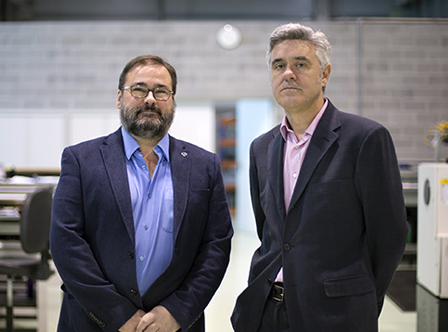
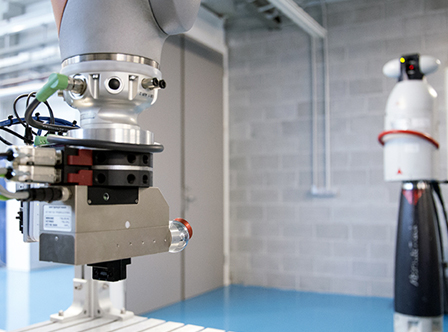
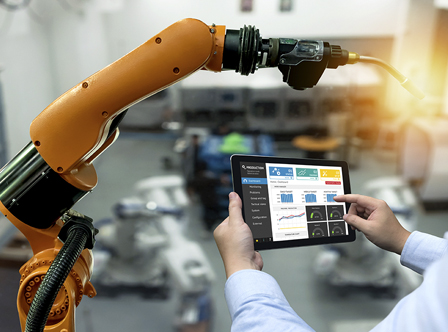
We are currently feeling a certain sense of expectation with regard to promises associated with technologies related to the so-called fourth industrial revolution. In order to understand what is happening now and will take place in the future, there is nothing better than looking back in time to review the developments reported since the third industrial revolution began.
It was in the 80s when substantial changes were about by the incorporation of electronics to machine tools and by the inception of CNC that made traditional machine tools obsolete.
Later, further progress was made in the implementation of flexible manufacturing lines equipped with cells usually featuring only one machine that were more profitable and reliable.
Subsequently to fitting machines with CNC, efforts began to focus on achieving a higher degree of accuracy in part manufacturing which gave rise to the incorporation of optical rulers, on-board machine measuring systems, calibration devices, etc.
Once the degree of accuracy that machine tools could achieve became clear, the next step focused on increasing profitability. As a result, new tools and machines with enhanced mechanical properties were developed (higher speeds, power ratings, torques, rigidities, etc.).
New systems were developed to reduce downtime (automatic loading and unloading, rapid tool and head changeovers, robots for multiple applications, etc.).
The next step was geared towards improving reliability. The introduction of open controls enabled real-time monitoring and processing to be performed by external sensors and internal drive signals; it also made it possible to monitor tooling condition, vibrations, collisions, etc., resulting in higher levels of autonomy and reliability.
More progress has been made in recent years in the production of multi-functional machines featuring several processes that can perform a larger number of operations in only one run without manipulating parts.
Another issue that was taken into account only a few years ago has to do with machine energy efficiency. Machines must be designed and dimensioned to reduce life cycle costs to the greatest possible extent and operate according to stringent environmental regulations.
Consequently, progress has been made thanks to new materials, less coolants, recycling and high-performance components resulting, among other things, in the need to use less shopfloor space.
The Industry 4.0 reference model applied to machine tools
The challenge the machine tool business is currently facing consists in how to approach the so-called "Industry 4.0" revolution and the many opportunities it offers with regard to the fact that more products and processes are being digitised.
From a technological perspective, there are many possibilities, although the question that the potential buyers and users of these machines are asking is how can they benefit from them? There is no easy answer, and this will obviously depend on each individual case.
In order to properly structure an analysis on “what is it I can to make my company more competitive and what features does a machine have to offer me”, it is better to have a reference model as shown in the next figure.
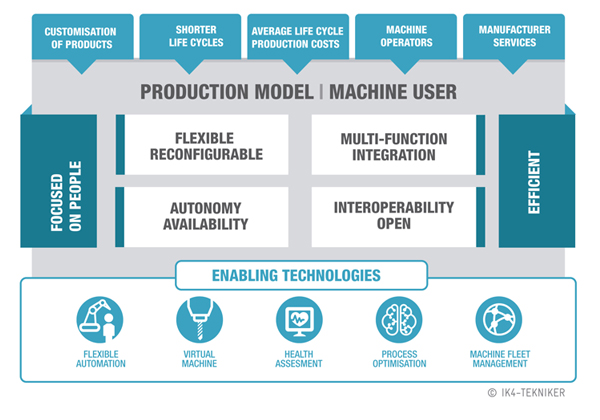
(This model specifically refers to a machine tool case of a generic Industry 4.0 model used by IK4-TEKNIKER to diagnose and identify opportunities connected to Industry 4.0)
This reference model seeks to guide machine tool buyers and users to evaluate the most interesting technological features of each individual case. Procurement criteria are not homogenous and may vary as a function of the business strategy established for each particular case and also with regard the production model addressed by the strategy.
As a starting point, attention must be paid to sectorial drivers, trends or factors pertaining to the environment where the company is already facing competition.
- Product customisation or the need to customise products for the end user.
- Shorter life cycles linked to the launching requirements of new products characterised by increasingly shorter lead times.
- The life cycle cost of production resources: Company managers are increasingly addressing investments and operating costs as a whole. Nowadays, there is en ever-growing demand for concepts such as “life cycle cost”.
- Availability of operators and skill-building: Operators that are becoming increasingly accustomed to using ITs but usually know less about manufacturing processes.
- Suppliers of production resources, who are increasingly offering more services related to predictive maintenance for machines are willing, in certain cases, to study new forms of payment or funding for their machines.
In terms of attributes, the advanced production model to be adopted in each case will feature, generally speaking, the following:
- Flexibility understood as the capacity to ultimately produce in a customised manner coupled with reconfigurability, understood as the capacity to adapt quickly and economically to changes in products.
- Multi-functionality or the capacity to perform a maximum number of operations on a part on the same machine, including ancillary operations such as work piece loading/unloading and on-site measuring.
- Intelligence incorporated to a machine to respond autonomously by supervising and ensuring that a process is producing defect-free parts, to monitor the condition of a machine and predict if any of its components can be expected to fail or cause a quality problem, etc.
- The capacity to connect and interoperate: Machines that can be integrated easily in the digitisation process of a company and allow for incorporation of third-party utilities.
- Efficiency to be achieved by optimising processes to obtain a high level of machine availability based on manufacturing with "zero defects".
- Focused on people, because people operate production systems and make sure they work properly.
Lastly, and with regard to possible supporting technologies, listed hereunder are those that could be potentially considered to be more relevant:
- A flexible and easy-to-reconfigure automation allowing, for instance, parts to be loaded and unloaded in production environments characterised by frequent turnovers of components arriving at the machine in containers.
- “A virtual machine” allowing for machine-process simulation and modelling that drastically reduces set-up stages for new processes.
- “A Health assessment” of the machine which, based on a characterisation test series, delivers practically continuous, real-time information on the condition of critical machine components that can be supplemented by self-calibration mechanisms for machine tools which only in a matter of minutes allows a verification to be carried out with regard to machine errors so that, should any tolerance biases be found, the unit can calibrate itself and carry on machining with greater accuracy.
- Process optimisation based on simulation models that are incorporated to machine monitoring so that decisions can be taken autonomously and intelligently with regard to process parameters and the dynamic conditions of different mechanical components that features real-time machine OEE (“Overall Equipment Efficiency”) monitoring capabilities to permanently update the operator/supervisor with regard to possible trends that might produce potential incidents.
It also helps the operator to discover root causes behind efficiency losses by searching for correlations between OEE and the different variables that could be related to its components (efficiency, availability and quality) by means of statistical and data mining tools. - Health condition is monitored locally together with associated data that can be exchanged with the machine manufacturer to offer added value services such as predictive maintenance.
We can look into how these technologies influence the attributes of the production model and ascertain to what extent they are actually in line with the drivers of my business. It has been noted that all produce the same impact.
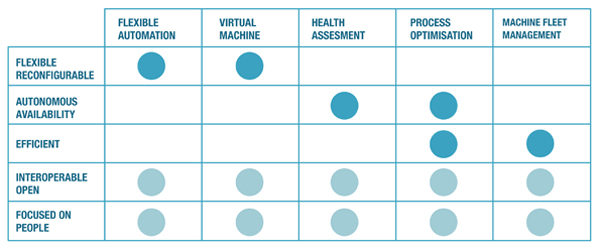
If, for instance, my business is related to the automotive sector, autonomy and efficiency will be my main focus, which means that machines will have to be equipped with suitable sensors to deliver autonomy and high levels of availability.
On the other hand, having a solution that will allow me to optimise a process will provide me with a differential element relative to my competition.
If my business is related to the aeronautical sector, I will require production solutions that allow me to make and launch new parts in a first attempt.
Concepts such “virtual machine” can be very helpful. Or other things such as "flexible automation", for instance, can transform certain automations that were unattainable into something far more more feasible nowadays.
It must be stressed that there are two characteristics: “Interoperable/Open” and “Focused on people” that should take into account any kind of technological solution.
Lastly, thought should also be given to another concept, namely, technological maturity, as it impinges on technological supply and demand; At this point in time, and due to the potential opportunities that are apparently available, multiple stakeholders are becoming involved to supplement a more traditional supply although we must bear in mind that not all of them will survive.
On the other hand, and from the point of view of somebody that buys and uses a machine, an organisation must be ready to capitalise on a few or many of the technologies that are being offered.



